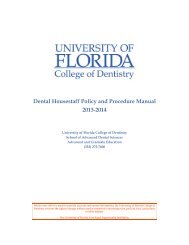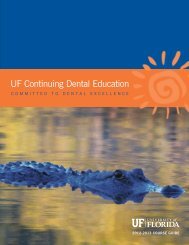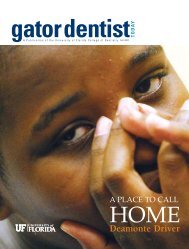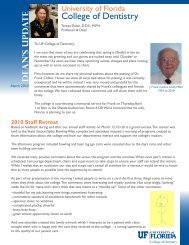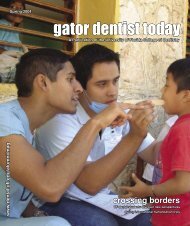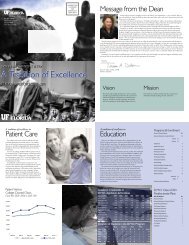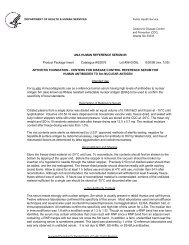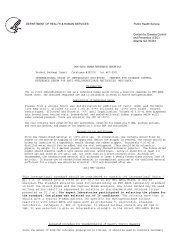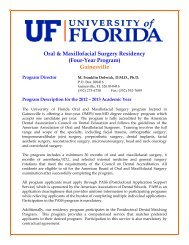gator dentist today - College of Dentistry - University of Florida
gator dentist today - College of Dentistry - University of Florida
gator dentist today - College of Dentistry - University of Florida
Create successful ePaper yourself
Turn your PDF publications into a flip-book with our unique Google optimized e-Paper software.
pr<strong>of</strong>ile<br />
in leadership<br />
Oral Biology<br />
Chair Robert Burne takes a<br />
bite out <strong>of</strong> bad bacteria<br />
By LINDY McCOLLUM-BROUNLEY<br />
Eew! That sticky goo growing on your teeth is plaque. But to<br />
Robert A. Burne, Ph.D., chairman <strong>of</strong> oral biology at the UF<br />
<strong>College</strong> <strong>of</strong> <strong>Dentistry</strong>, it’s bi<strong>of</strong>ilm and it’s beautiful.<br />
A microscopic view <strong>of</strong> bi<strong>of</strong>ilm reveals surrealistic<br />
strands <strong>of</strong> bacteria draped in graceful loops and serpentines,<br />
forming great, clustered colonies on the porous tooth surface<br />
that can erode tooth enamel and invade gingival tissues and<br />
cells to cause periodontal disease.<br />
The typical human mouth supports a whole host <strong>of</strong><br />
bacteria — all living, reproducing and dying by the millions<br />
inside our mouths, for the most part without our knowledge.<br />
Most <strong>of</strong> these bacterial strains have lived in harmony with our<br />
species for hundreds <strong>of</strong> thousands <strong>of</strong> years, coexisting inside<br />
our mouths with a minimum <strong>of</strong> fuss.<br />
That was until our diets changed, and we began feeding<br />
the bacteria too much sugar.<br />
Now some strains <strong>of</strong> sugar-pumped bacteria, most<br />
notably Streptococcus mutans, reproduce helter-skelter inside our<br />
mouths, gobbling up the glucose from the foods we chew and<br />
excreting corrosive lactic acid onto our tooth enamel. Before you<br />
know it, you’ve got a full-blown case <strong>of</strong> dental caries, and the<br />
chemical balance inside<br />
your mouth favors the<br />
reproduction <strong>of</strong> the bad<br />
bugs over the benign.<br />
Burne, recruited<br />
from the <strong>University</strong><br />
<strong>of</strong> Rochester School <strong>of</strong><br />
Medicine and <strong>Dentistry</strong> in<br />
2001, is working to develop<br />
a genetically engineered<br />
strain <strong>of</strong> bacteria that will<br />
defeat the bad bugs such<br />
as S. mutans. His research<br />
has shown a certain strain<br />
<strong>of</strong> common oral bacteria<br />
produces ammonia and<br />
it beats the bad bugs by<br />
changing the pH balance<br />
inside the mouth. There<br />
is evidence that the<br />
Photo - Courtesy UF Oral Biology<br />
10 Gator Dentist Today Fall/Winter 2003<br />
Photo - Lindy Brounley<br />
elevated pH balance may even encourage remineralization <strong>of</strong><br />
the tooth enamel. Burne’s idea is to develop a super strain <strong>of</strong><br />
this ammonia-producing bacteria that could be introduced into<br />
a person’s mouth very early, providing a lifetime <strong>of</strong> protection<br />
against tooth decay.<br />
Burne is not alone in the battle against bad bacteria. He<br />
leads a department <strong>of</strong> talented researchers dedicated to exploring<br />
the molecular biology <strong>of</strong> oral diseases. The department’s<br />
research focuses on microbiology and immunology, and its<br />
research faculty is, per capita, among the most productive in<br />
the nation in garnering National Institutes <strong>of</strong> Health research<br />
award funding — increasing from $3 million in NIH funding<br />
in 2000-01 to more than $9 million <strong>today</strong>, a meteoric increase <strong>of</strong><br />
more than 200 percent.<br />
Planning for the Future<br />
To help the college establish a blueprint for<br />
further expansion, Burne penned a winning NIH Research<br />
Infrastructure Planning Grant proposal, funded this fall.<br />
The Research Infrastructure Planning Grant will facilitate a<br />
comprehensive inventory <strong>of</strong> all research under way in the<br />
college, the amount <strong>of</strong> square footage devoted to research<br />
activities, research equipment and personnel, as well as<br />
multidisciplinary partnerships and collaborative opportunities<br />
for college researchers within the university and the UF Health<br />
Science Center.<br />
“I think this college is extremely strong in basic science<br />
research, and it has been very successful over the last few years,”<br />
Burne said. “Yet there is a tremendous amount <strong>of</strong> untapped<br />
potential, especially in periodontal research, pain research and<br />
clinical translational research. The infrastructure planning grant<br />
will enable us to identify our strengths and weaknesses in terms<br />
<strong>of</strong> potential.”



